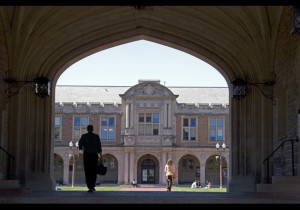In September 1900, the office of Walter Cope and John Stewardson (who had died a few years earlier) produced a report in conjunction with their plan for the new campus for Washington University in St.Louis. The report is titled “Explanation of Drawings,” and a large part is devoted to a discussion of architectural style, specifically of Classical and Gothic. The authors argue for the latter (the firm more or less invented Collegiate Gothic), on the basis of cost, adaptability, scale, and appropriateness to an educational institution. They also point out the sentimental connection that exists between Gothic and institutions of higher learning, which evolved side by side in the Middle Ages. “If we ignore true sentiment in architecture we shall have little left,” they add. I realized when I read this that this is precisely what disturbs me about the current fashion in architectural design. Buildings have eliminated all sentiment. They may be ingenious and complex, but they are so in a way that is hermetic and self-contained. Instead of “looking like” buildings, that is, establishing a sentimental tie with the long arc of history, they merely look forward into an unknown future. Perhaps that’s why they remind me of giant appliances.



Liked this post so much I quoted most of it over on mine, making the connection to modern music.
http://registeredmusictherapist.blogspot.com/2016/01/modern-architecture-modern-music.html
Been a regular reader for years – thanks for the work of keeping up the blog.
I see the continuation of this theme in your “the campus as petting zoo” article….which i truly enjoyed. This could also be a model showing the discontinuity impact of new buildings in historic districts in both stylistic and economic terms.